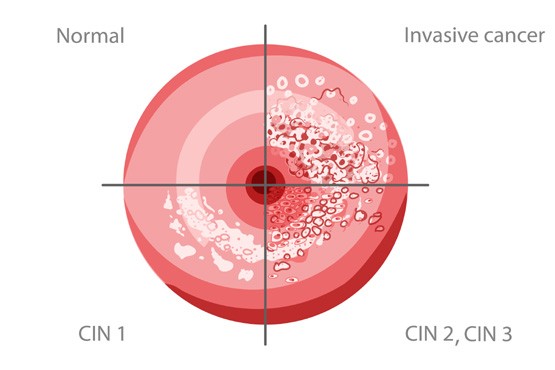What is CIN I-II-III ?

What is CIN?
CIN is an acronym for Cervical Intraepithelial Neoplasia. This term refers to a condition in the cervix where cells grow abnormally. Even though the term "neoplasia" means cancer in Latin, CIN does not necessarily mean cancer.
CIN is divided into three different degrees depending on the rate of cell growth and how far the growth has spread: CIN 1, CIN 2, and CIN 3.
How is CIN diagnosed?
CIN (Cervical Intraepithelial Neoplasia) is usually diagnosed with colposcopy and biopsy. Colposcopy is the process of examining the cervix using a special microscope. After abnormal looking areas are identified, cell samples are taken from these areas. This process is called a biopsy. The samples taken are examined under a microscope in a laboratory environment and a pathology report is prepared.
What are LSIL and HSIL?
How is LSIL/HSIL diagnosed?
LSIL/HSIL is diagnosed by a smear test (Pap Smear). This is a screening test where cell samples are taken from the cervix. The smear test is used to detect abnormal cells and if any abnormalities are found in this test, a biopsy is recommended for a more detailed examination.
What is the difference between CIN1,2,3 and LSIL/HSIL classifications?
LSIL and HSIL are usually determined by a Pap smear (or Pap test). This test is done by examining cell samples taken from the cervix in a laboratory. The Pap smear test is used to detect abnormalities at the cellular level, and this helps prevent cervical cancer with early intervention and treatment.
CIN is usually determined by a biopsy. Biopsy is a more invasive test usually done during a colposcopy (an enlarged view of the cervix). During this procedure, the doctor takes a small tissue sample from the cervix. This tissue sample is then examined under a microscope in the lab. The degree of CIN (CIN 1, CIN 2, or CIN 3) depends on the severity and prevalence of cell abnormalities.
In conclusion, while Pap smear tests usually determine LSIL and HSIL, CIN is usually determined by a biopsy. Both tests are used to detect abnormalities in cervical cells, but they provide different levels of detail.
This article may also interest you

The issue of what kind of effects the genital warts developing during pregnancy will have on the baby and how the delivery will take place are still being discussed today.
Read more

 TR
TR EN
EN